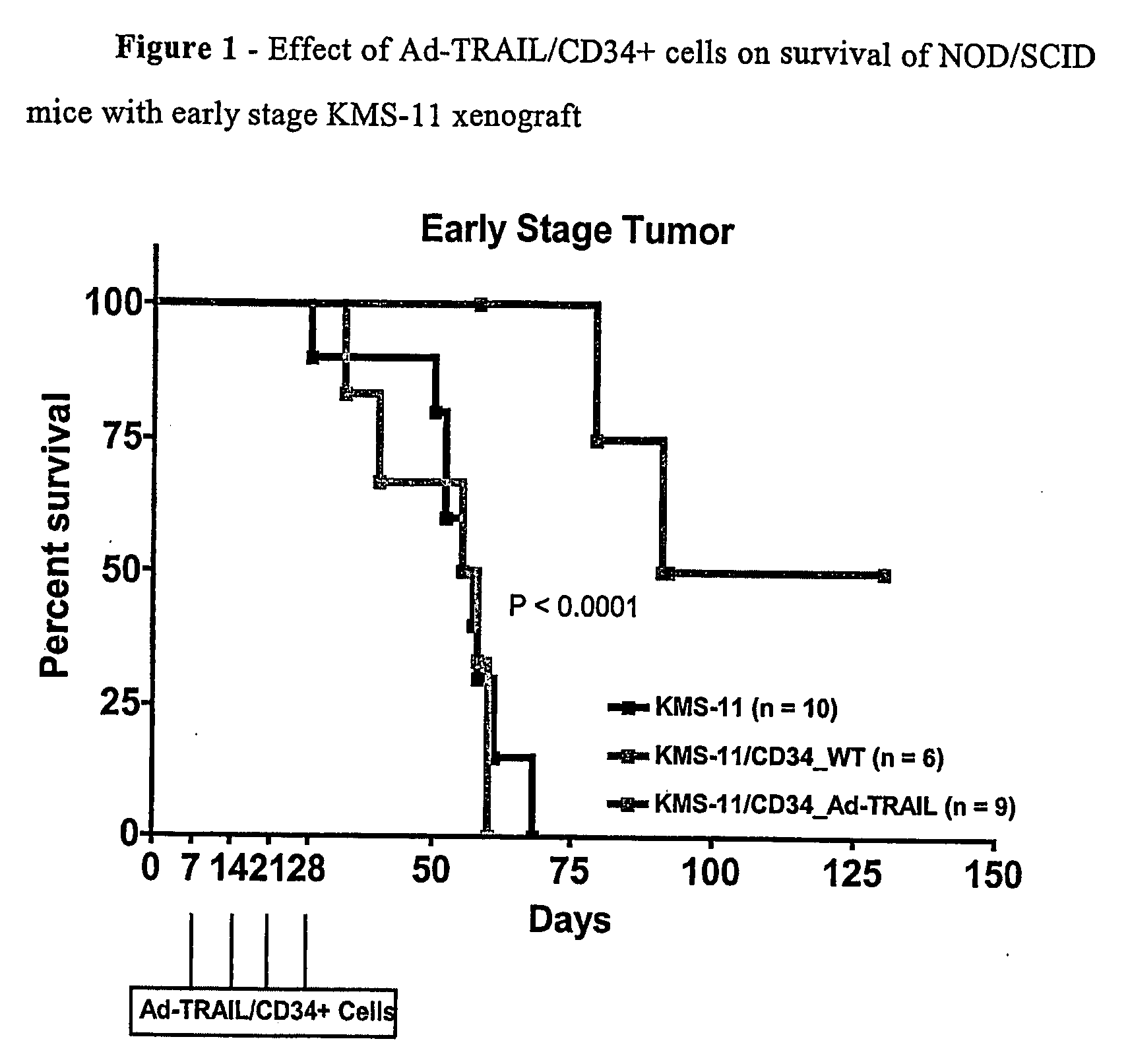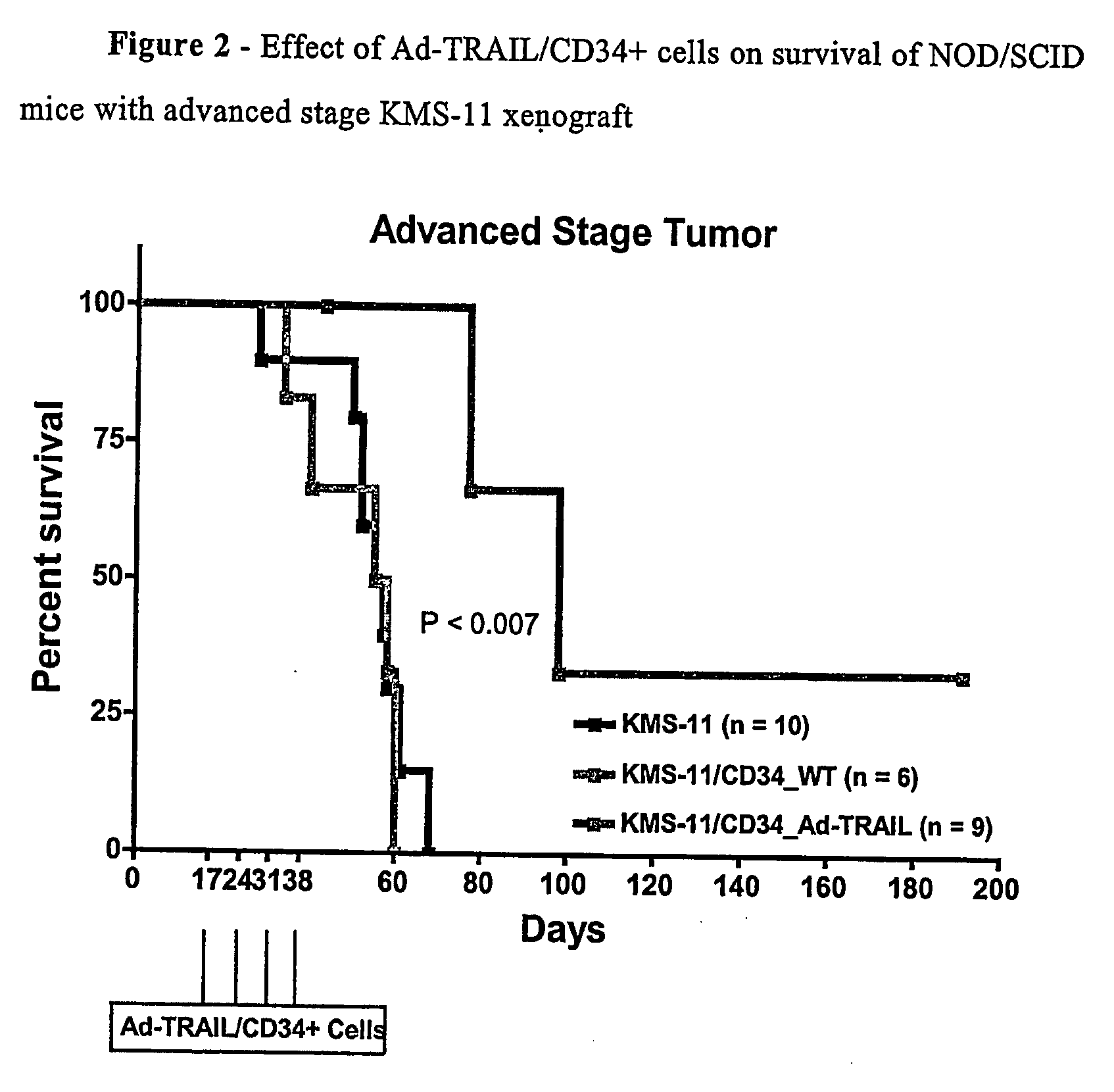Tumor-Homing Cells Engineered to Produce Tumor Necrosis Factor-Related Apoptosis-Inducing Ligand (Trail) by Adenoviral-Mediated Gene Transfer
a tumor-homing cell and gene transfer technology, applied in the field of tumor-homing cells expressing tumor necrosis factor-related apoptosis inducing ligands, can solve the problems of lack of clinical value, limitation of the use of soluble trails, and lack of reasonable expectation of success
- Summary
- Abstract
- Description
- Claims
- Application Information
AI Technical Summary
Benefits of technology
Problems solved by technology
Method used
Image
Examples
example 1
In vitro Triggering of Apoptosis in Lymphoma Cell Lines Co-Cultured with CD34+ Cells or NK Cells Expressing TRAIL Following Adenoviral-Mediated Gene Transfer
[0033] The effects of co-culturing lymphoma cell lines with CD34+ cells or NK cells engineered to express TRAIL following adenoviral-mediated gene transfer were evaluated.
[0034] In initial in vitro experiments, an adenoviral vector expressing TRAIL (Ad-TRAIL) was used to set up optimal conditions for adenoviral infection of CD34+ cells and NK cells. The time-course of TRAIL expression on CD34+ and NK cell surface was subsequently monitored by using a PE-conjugated anti-TRAIL monoclonal antibody (clone Rik-2). Finally, the capacity of membrane-bound TRAIL to induce apoptosis of lymphoma cell lines was evaluated by co-culturing Ad-TRAIL / CD34+ cells or Ad-TRAIL / NK cells and lymphoma cell lines.
[0035] Methods
[0036] Adenovirus encoding the human TRAIL gene. A replication-deficient adenovirus encoding the human TRAIL gene (Ad-TRAI...
example 2
In vivo Evaluation in NOD / SCID Mice of the Anticancer Activity of CD34+ Cells or NK Cells Engineered to Express TRAIL Following Adenoviral-Mediated Gene Transfer
[0061] In order to investigate the therapeutic potential of Ad-TRAIL / CD34+ cells or Ad-TRAIL / NK cells, NOD / SCID mice were reinfused with the TRAIL-sensitive KMS-11 multiple myeloma cell line. Subsequently, mice were injected with Ad-TRAIL / CD34+ cells or Ad-TRAIL / NK cells and mice survival was used as a readout of the antitumor efficacy of cell-based TRAIL delivery.
[0062] Methods
[0063] Evaluation of the antitumor activity of Ad-TRAIL / CD34+ cells or Ad-TRAIL / NK cells. Six- to eight-wk-old female NOD / SCID mice with body weight of 20 to 25 g, were purchased from Charles River (Milano, Italy). Mice were housed under standard laboratory conditions according to our institutional guidelines. Experimental procedures performed on animals were approved by the Ethical Committee for Animal Experimentation of the Istituto Nazionale Tum...
example 3
In vitro Antitumor Activity of CD34 / Ad-TRAIL Cells Against Breast Cancer Cell Lines
[0071] A significant proportion of breast cancer cell lines is resistant to TRAIL-induced apoptosis due to a number of mechanisms, including TRAIL sequestering by TRAIL decoy receptors, loss of expression of R1 and R2 receptors, FLIP overexpression, etc. [40]. Based on our previous results showing that sTRAIL-resistant lymphoma cell lines become indeed TRAIL responsive when exposed to mTRAIL, we investigated the sensitivity of two breast cancer cell lines to sTRAIL and mTRAIL.
[0072] The sensitivity of breast cancer cell lines to the killing effects of sTRAIL was evaluated in comparison with the evaluation of the in vitro triggering of apoptosis of sTRAIL-sensitive and sTRAIL-resistant breast cancer cell lines co-cultured with CD34 / Ad-TRAIL cells.
[0073] Two breast cancer cell lines, i.e., MCF-7 and MDA-MB-361 were used. In order to evaluate the sensitivity of individual cell lines to the killing eff...
PUM
| Property | Measurement | Unit |
|---|---|---|
| body weight | aaaaa | aaaaa |
| pH | aaaaa | aaaaa |
| concentrations | aaaaa | aaaaa |
Abstract
Description
Claims
Application Information
 Login to View More
Login to View More - R&D
- Intellectual Property
- Life Sciences
- Materials
- Tech Scout
- Unparalleled Data Quality
- Higher Quality Content
- 60% Fewer Hallucinations
Browse by: Latest US Patents, China's latest patents, Technical Efficacy Thesaurus, Application Domain, Technology Topic, Popular Technical Reports.
© 2025 PatSnap. All rights reserved.Legal|Privacy policy|Modern Slavery Act Transparency Statement|Sitemap|About US| Contact US: help@patsnap.com



